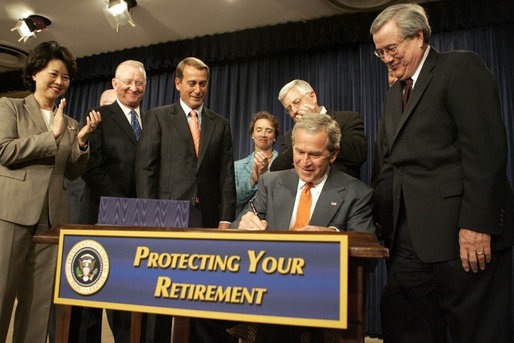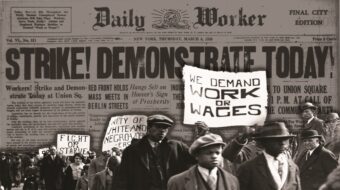
WASHINGTON (PAI) – The 2007-08 financial crisis, spurred by Wall Street’s “casino capitalism,” still threatens pension plans that affect 10 million workers. A joint task force of union and employer representatives is working on ways to resolve the financial ailments affecting dozens of multi-employer pension plans (MEPPs), representatives of both groups recently told Congress.
At a House committee hearing in March, the representatives, along with the head of the federal Pension Benefit Guaranty Corp., (PBGC) asked lawmakers for needed authority in federal laws to let them make those fixes. PBGC steps in to pay a low level of benefits when a traditional “defined benefit” pension plan goes belly-up.
“The multi-employer system was designed more than a generation ago. The world has changed but the system has not. The challenges facing the multi-employer system are complex and somewhat different from those faced by single-employer defined benefit plans,” said PBGC Director Joshua Gotbaum.
Solvency of MEPPs is important to more than 10 million workers. There are 819 MEPPs in construction alone. They cover 3.9 million workers, or 37 percent of workers in MEPPs nationwide, said Harold Force, president of Force Construction of Columbus, Ind., speaking for the pro-union Associated General Contractors.
But construction isn’t the only industry with many MEPPs. For example, the United Food and Commercial Workers co-manages more than 60 with its employer partners, Secretary-Treasurer Anthony Perrone testified. Those plans cover 700,000 active workers and another 700,000 retirees. The largest of them, the $5.2 billion UFCW Industry Pension Fund, covers 92,000 workers at more than 500 employers.
The 2007-08 stock market crash and the great recession doubly slammed the MEPPs, witnesses told lawmakers. Perrone said MEPP plans’ assets value dropped by 20 percent-30 percent. In some – not all – cases asset value has only now returned to 2007 levels. Expected annual returns of 7 percent-8 percent disappeared, too.
So many people became unemployed that the ratio of active to inactive workers in construction, which used to be 2-to-1 for active workers, is now 4-to-3 for inactive ones, Force said. Employer contributions, based on hours worked, dropped 40 percent.
At the same time, a new Pension Protection Act (PPA) took effect, imposing higher contribution requirements on those MEPPs, as well as on traditional single-employer pension plans, that are seriously underfunded, the witnesses said.
Some plans fold. Then the PBGC must take over payouts, which only average $13,000 yearly per worker, said Gotbaum. In others, employers who can not afford higher premiums or payments drop out, increasing the load on remaining firms, and increasing the risk of financial distress for the plan.
“Pension plan funding ratios today are more sensitive to investment risk because the plans have matured,” Perrone explained. Because of an aging workforce, “the plans are now paying more in benefits than receiving in contributions, resulting in negative cash flow.
“As a result, investment returns are critical. When returns fall below expected assumptions, the impact on the funding ratio is dramatic…A significant number of plans are one bad investment year away from triggering red zone critical status.”
To try to work out solutions to MEPPs’ problems, the National Coordinating Committee on Multi-Employer Plans, a joint union-management group, established its own task force, Perrone and Force told lawmakers.
One task force recommendation, Force said, is “additional security” for MEPPs that weathered the crash, those “on the path to recovery” measured by rehab blueprints and for MEPPs “that, with expanded access to tools in the PPA and (in) subsequent relief legislation, will be able to achieve their statutorily mandated funding goals.”
The task force also recommends “limited authority” for MEPP trustees to “partially suspend accrued benefits” for workers and retirees and “partial suspension of benefits in pay status for retirees.” The trustees, under PBGC supervision, could take those moves to prevent a financially endangered plan from becoming insolvent.
And it recommends giving trustees flexibility to create new MEPP plan designs, to help prevent insolvency. Perrone said UFCW just worked out a new plan design with Kroger, to let the grocery chain merge four shaky MEPP plans into one larger whole and borrow $1 billion, at low interest, on the market, to bring it from 71 percent funding to 100 percent.
But Charles Jeszeck, director of the pension section for the non-partisan Government Accountability Office, painted a direr picture. He said not only are many MEPPs in financial trouble, but if two big ones – with liabilities totaling $26 billion-become insolvent in 2023, as current projections show, paying their covered workers would drain PBGC’s MEPP insurance fund.
“A substantial number of plans, including some very large plans, are facing very severe financial difficulties,” Jeszeck said. “Many reported no realistic combination of contribution increases or allowable benefit reductions – options available under current law to address their financial condition – will enable them to emerge from critical status.”
Photo: When President Bush signed into law what he called “the most sweeping reform of America’s pension laws in over 30 years, the Pension Protection Act of 2006,” ctitics warned it could put defined-benefit pensions at risk (Wikimedia).












Comments